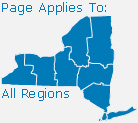Air
Air pollution can harm human health, and damage all the elements of the ecosystem. For nearly four decades, state and federal governments have controlled the emission of pollutants through permits with enforceable requirements, and have measured and monitored pollution levels in the air.
DEC is the state agency that carries out both the state and federal air pollution control and monitoring programs. This website includes detailed information about how New York State controls air pollution, offering data gathered by the air program and information about the sources and effects of air pollution.
Sources and Effects of Air Pollution
Air pollutants originate from many human activities. Most pollutants come from industries that manufacture chemicals and other goods, from on- and off-road vehicles and power equipment, and from energy facilities that burn oil, gas or coal. Pollutants emitted from tall stacks move high in the air, descending to earth to do damage miles downwind from their source.
Air pollution damages health and the environment in a variety of ways. Hot summer weather sets the stage for formation of ozone (O3) and fine particulate matter (PM2.5), two pollutants of concern for human health. Fish and wildlife show harmful effects from acid rain and mercury in air. So-called greenhouse gases (chiefly carbon dioxide) in the air may be changing the world's climate.
New York's Air Pollution Control Program
The federal and state air pollution programs include permits and technical requirements to control emission of pollutants, along with extensive measurement and monitoring of ambient pollutant levels. A key element of the program is the Vehicle Inspection and Maintenance Program, which checks vehicle emissions and requires repairs to failed pollution control equipment.
Federal law requires DEC to submit a State Implementation Plan that demonstrates how state air pollution control programs will be carried out to reduce pollution and to ensure that air contaminant levels are in compliance with the National Ambient Air Quality Standards (NAAQS). The SIP includes plans to bring areas that contravene the NAAQS into attainment.
This website includes information about applying for permits, about permits already granted and currently under consideration, and about measurements of air pollutants, both current levels and data for years past.
More about Air:
- Air Quality Index (AQI) Forecast and Current Observations for New York State - AQI forecast, current hourly air quality measurements
- Ambient Air Quality Monitoring - New York State ambient air monitoring networks
- State Implementation Plan - New York prepares a plan, known as a SIP, that outlines control strategies to reduce air pollution in nonattainment areas.
- About Ozone - Ozone, a major component of smog and a potentially harmful pollutant, is created by sunlight reacting with chemicals found in gasoline vapors and emissions from cars and industrial smoke stacks
- Controlling Air Pollution from Facilities - Industrial and commercial operations emit pollutants into the air. These pollutants can make breathing difficult, form urban smog, impair visibility, and attack ecosystems
- Controlling Vehicle Pollution - How DEC controls pollution from cars, trucks and other vehicles
- Vehicle Inspection & Maintenance - Inspection and Maintenance (I/M) emissions testing for motor vehicles
- Don't Trash Our Air - What happens when you burn household garbage and trash in a backyard burn barrel


